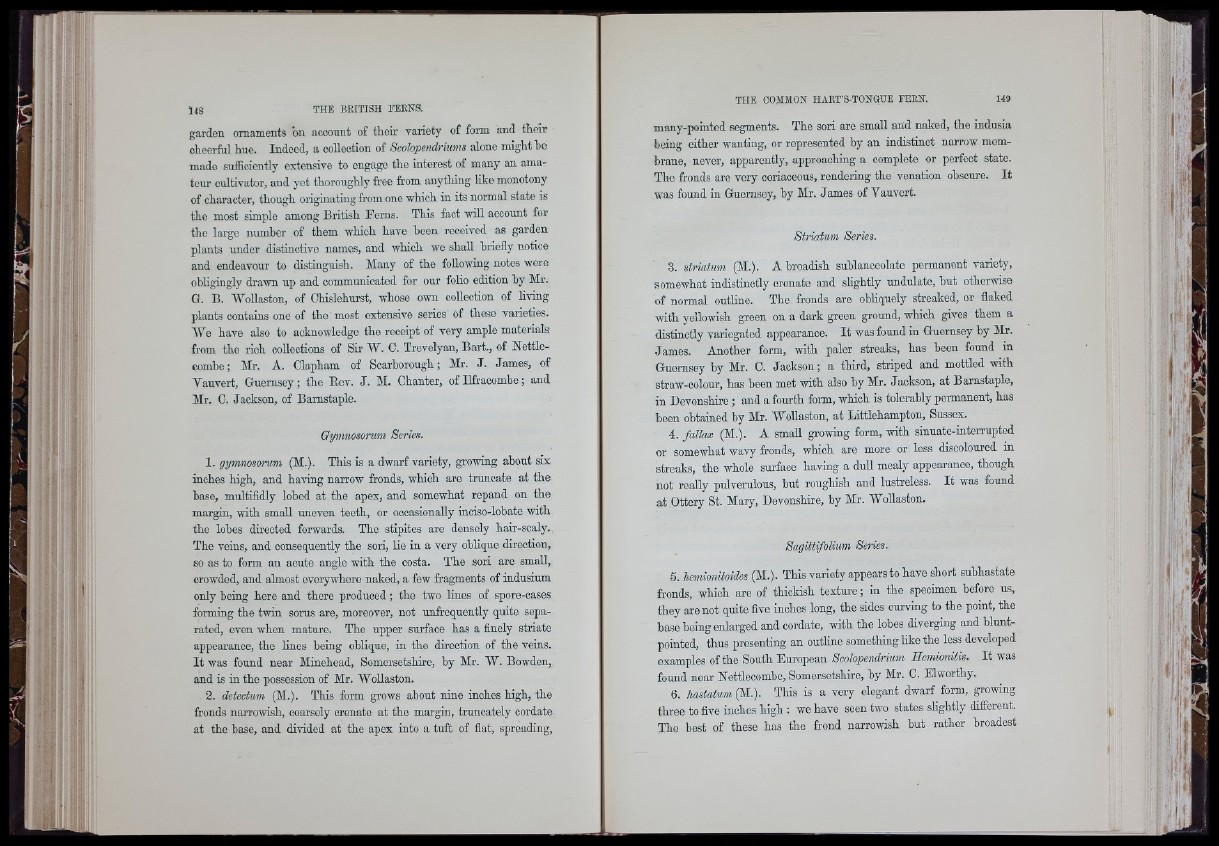
r i - - t r i
-is-
S' f' •
( h ■
■i fii )i
garden ornaments bn account of their variety of form and their
cheerful hue. Indeed, a coUeotion of Scolopendriums alone might ho
made sufficiently extensive to engage the interest of many an amateur
cultivator, and yet thoroughly free from anything hlce monotony
of character, though originating from one which in its normal state is
the most simple among British Foms. This fact will account for
the largo number of them which have been received as garden
plants under distinctive names, and which wo shaU briefly notice
and endeavour to distinguish. Many of the following notes were
obligingly drawn up and communicated for our folio edition by Mr.
G. B. 'Wollaston, of Chislehurst, whose own collection of living
plants contains one of the most extensive series of these varieties.
We have also to acknowledge the receipt of very ample materials
from the rich coUections of Sir W. 0. Trevelyan, Bart., of Nettle-
comhe; Mr. A. Clapham of Scarborough; Mr. J . James, of
Yauvert, Guernsey; the Eev. J. M. Chanter, of Ilfraoomhe; and
Mr. C. Jackson, of Barnstaple.
Gymnosorum Series.
1. gymnosorim (M.). This is a dwarf variety, growing about six
inches high, and having narrow fronds, which are truncate at the
base, multifidly lobed at the apex, and somewhat repand on the
margin, with smaU uneven teeth, or occasionaUy inciso-lobate with
the lohes directed forwards. The stipites are densely hair-scaly.
The veins, and consequently the sori. He in a very oblique direction,
so as to form an acute angle with the costa. The sori are smaU,
crowded, and almost everywhere naked, a few fragments of indusium
only being here and there produced; the two lines of spore-cases
forming the twin sorus are, moreover, not unfrequently quite separated,
even when mature. The upper surface has a finely striate
appearance, the lines being oblique, in the direction of the veins.
It was found near Minehead, Somersetshire, by Mr. W. Bowden,
and is in the possession of Mr. WoUaston.
2. detectum (M.). This form grows about nine inches high, the
fronds narrowish, coarsely crenate at the margin, truncately cordate
at the base, and divided at the apex into a tuft of flat, spreading.
many-pointed segments. The sori are smaU and naked, the indusia
being either wanting, or represented by an indistinct narrow membrane,
never, apparently, approaching a complete or perfect state.
The fronds are very coriaceous, rendering the venation obscure. It
was found in Guernsey, by Mr. James of Vauvert.
Striatum Series.
3. striatum (M.). A broadish sublanoeolate permanent variety,
somewhat indistinctly oronatc and sUghtly undulate, bnt otherwise
of normal outline. Tho fronds are obUquoly streaked, or flaked
with yeUowish green on a dark green ground, which gives them a
distinctly variegated appearance. It was found in Guernsey by Mr.
James. Another form, with paler streaks, has been found in
Guernsey by Mr. C. Jackson; a third, striped and mottled with
straw-colour, has been met with also by Mr. Jackson, at Barnstaple,
in Devonshire ; and a fourth form, which is tolerably permanent, has
been obtained by Mr. WoUaston, at Littlehampton, Sussex.
4. fallax (M.). A smaU growing form, with sinuate-interrupted
or somewhat wavy fronds, which are more or less discoloured in
streaks, the whole surface having a duU mealy appearance, though
not really pulverulous, but ronghish and lustreless. It was found
at Ottery St. Mary, Devonshire, by Mr. WoUaston.
- I'l
SagittifoUum Series.
5. hemionitoides (M.). This variety appears to have short subhastate
fronds, which are of thiekish texture; in the specimen before us,
they are not quite five inches long, the sides curving to the point, the
base being enlarged and cordate, with the lohes diverging and blunt-
pointed, thus presenting an outUne something Hke the less developed
examples of the South European Scolopendrium Hemionitis. It was
found near Nettlecombe, Somersetshire, by Mr. 0. Elworthy.
6. hastatumQl.). This is a very elegant dwarf form, growing
three to five inches high : we have seen two states sUghtly different.
The best of these has the frond narrowish hut rather broadest
•t *
, {' ■
i f
■ f i . .
J - f :
R i i